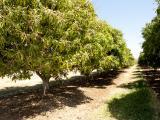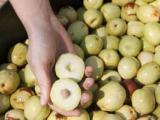How to grow
Soils should be well-drained, preferably with a slightly acidic to neutral pH. Most tropical plants need regular supplies of good quality water, especially during the warmer months. Fertilise every six weeks in the warmer months with a complete fertiliser containing magnesium and trace elements or use a six month, complete slow release fertiliser twice yearly.
October is the ideal month for planting. In general, grow plants of named varieties that have been propagated by cuttings, budding and grafting, and not grown from seed. Select an area that is protected from wind and is preferably facing north, with full sun for most of the day. Incorporate generous quantities of organic material like compost and soil conditioner into the soil and mulch with free draining bark chip material which should be kept away from the stem of the plant. Clay soils should be made more friable (easy to crumble) with the use of dolomite and sandy soils improved with the application of 5% clay to help them retain moisture.
Young trees may need protection from frost using 50% density shade-cloth for up to three years after planting. They will survive light frosts once established.
Temperatures in south west Western Australia are hotter than those experienced in many tropical areas and plants like avocados and mangoes may show marginal leaf scorch due to salinity and/or damage from hot winds as they are unable to draw enough water from the soils when the temperatures are very hot. Foliage of seedling trees can be protected with a spray of an acrylic polymer which reduces transpiration from the leaf by up 50% and lasts for up to 90 days. This product will also reduce frost damage.
Easterly winds in late spring can result in considerable loss of young fruits. To prevent sunburn, the stems of some fruit trees (especially mango and avocado) can be painted with a white, water-based paint.
Prune bananas, coffee and passionfruit regularly.
Pests
The most severe pest of tropical fruit trees is Mediterranean fruit fly which is especially bad on soft fruits like custard apples, guavas, passion fruit, sapodillas, mango and white sapotes. The fruit can be protected from fruit fly attack (plus birds and sun damage) by covering with bags made from fine net or paper or use exclusion netting over the entire tree once the fruits have formed. This is only possible if trees are pruned so they do not grow too big. Fruit fly traps should also be installed in the trees.
Sucking insects like aphids, mealy bug and scales can attack trees and be controlled by organic products like horticultural oil (scale and mealy bug) or garlic and chilli spray.
The root-knot nematode can damage the roots of most fruit trees, especially bananas, pawpaws and passionfruit and can be seen as swellings on the roots. Damage can be reduced by adding organic matter to the soil.
Rats will eats fruits but can be controlled with baits and birds like ‘twenty-eight’ parrots, black cockatoos and silvereyes can damage fruits. Protect trees with bird netting.
Avocado
Avocado (Persea americana) are medium-sized sub-tropical trees with fruits maturing from May to February, depending on the variety and the area. Mature fruit are picked hard and ripen after they are removed from the tree.
'Hass' is a late yielding variety that does not need cross pollination from other varieties. However, for better pollination and spread of harvesting, interplant 'Hass', or the mid season variety 'Wurtz' (suitable smaller tree for a big pot) with the early variety 'Bacon', or the mid season varieties 'Fuerte' and 'Sharwil'.
Roots can be damaged by jarrah dieback (Phytophthora cinnamoni). Affected trees should be injected or young trees sprayed with phosphorous acid. Fruits may be damaged by anthracnose, which is controlled with copper sprays.
Banana

The most available varieties of Bananas (Musa spp) in WA are 'Williams' or 'Cavendish'. 'Goldfinger' is a newer variety that grows well in cooler areas. Plantains produce inferior quality fruits which are only suitable for cooking.
Plant suckers when they are about 40–70cm tall. The first bunch of fruits should be harvested in less than 27 months and thereafter bunches should be harvested from adjacent stems, at any time in the year, about every 18 months.
The number of plants that are growing in a clump must be closely controlled. With established clumps, suckers will emerge at the base of the main plant. These should be selected so there is one ‘stem’ that is about 1–2m high with one small sucker less than 20cm high, besides the main ‘stem’ that is bearing a bunch. Remove surplus suckers.
A bunch of bananas consists of 7 to 10 ‘upturned hands’, each of which has about 14 bananas. The fruit is ready for harvesting about six to nine months after flower emergence. For protection from sunburn and physical damage place coloured, bottomless polythene bags over the bunches.
If bananas are allowed to mature on the plant, they may ripen all at once to the yellow, edible stage. To extend the consumption time a hand of green bananas can be removed every few days for about six weeks before fruits turn yellow on the palm. These will mature in a pantry. Commence harvesting as soon as the bananas lose their angular sides, start to fill and become more rounded.
Custard apple
There are many types of custard apples within the Annona genus. Most are crosses of Annona cherimoya and Annona squamosa and the most popular named varieties are ‘African Pride’ or ‘Pink Mamoth’. It is a tree which produces segmented fruit that ripen in spring. They are ripe when light green, have softened slightly and have a sweet, creamy taste. Flowers need hand pollination to give the best results. The flowers are female in the morning when petals are unopened and male in the evening when the petals are fully opened. So either swirl a small paint brush around the pollen in opened male flowers in the morning and then poke it into female flowers that are barely opened or collect pollen from older open flowers in the evening and store in a jar and brush it on the almost closed flowers the next day.
Macadamia
The smooth leaf (Macadamia integrifolia) and rough leaf (Macadamia tetraphylla) types of macadamia are natives of Queensland and northern NSW. Macadamias available to home gardeners should grow from 5-9m and need wind protection and ample summer water when young. Nuts are harvested from April to September, depending on the variety and can be picked from the tree or from the ground.
Mango

Mango (Mangifera indica) trees grow slowly from 4–8m in Perth and start producing fruit from three to four years old. 'Kensington Pride' is the main variety and ripens in March, whilst 'R2E2' is one to two weeks later with slightly larger fruit. 'Kensington Pride' is unusual because it produces ‘true-to type’ from seed. 'King Thai' is a semi-dwarf variety to 3.5m tall with red blushed fruits similar in flavour to 'Kensington Pride'.
The main problem is from the fungal disease, anthracnose which attacks all parts of the plant. Control with cupric hydroxide or mancozeb.
Pawpaw
The pawpaw plant (Carica papaya), also known as papaya, has a strong, stem up to 5m high, with large leaves. Pawpaws are usually unbranched, so they require less space than most fruit trees. They live for about five years so can be grown close to other establishing fruit trees.
There are two types of pawpaws. Bisexual pawpaws have both male and female organs in the same flower, but are less suitable than the monosexual type in cooler climates. This has male and female flowers that are produced on separate plants. Seedlings may be easily raised in a home garden. It is not possible to determine the sex of monosexual plants before flowering so plant surplus seedlings and thin out when they show their first flowers about 7 to 13 months after transplanting. Aim to have about four female trees and two male trees. The female plants of the monosexual type have yellow-fleshed fruits that grow tightly clustered around the main stem. Fruit are ready for harvesting about 7 to 12 months after flowering. On male plants, flowers are borne on long, thin stalks. They provide pollen for fertilising the flowers on the female trees.
Fruit rots may be a problem in the cooler months, but are often superficial and the remainder of the fruit may be of good quality.
The first fruits should be harvested about 18 to 24 months after transplanting and thereafter fruit should be harvested regularly from November to June for the next three to four years. Pawpaws can be allowed to mature on the plant until most of the fruit has turned from green to orange-yellow and ripened inside a pantry in the house. As pawpaws are grown only from seedlings the quality of the fruit is variable.
Other tropical plants
Barbados cherry
Big, fast growing bush (Malphigia glabra) 2–5m also known as the acerola cherry, with small red cherry like fruits from January to April. High in vitamin C.
Brazilian cherry
Slow growing, medium tree (Eugenia uniflora) to 7m with small, red, fluted, fruits with a refreshing taste in autumn.
Black sapote
Medium tree (Diospyros digyna) to 6m with thin-skinned fruit with brown pulp that tastes like chocolate mousse.
Coffee
Medium bush (Coffea arabica) with small red fruits in early summer. These contain beans that can be roasted. Grow in semi-shade.
Dragonfruit
A climbing Hylocerus cactus with night scented flowers and melon-like fruits with fine black seeds, Needs support.
Drumstick
Unripe pods on the drumstick tree (Moringa oleifera) develop in March and are used in curries. The tree has edible leaves and roots and can grow to 5m so keep it pruned to easily harvest pods.
Guava
Medium sized tree (Psidium guajava) to 5m with pink or red aromatic fruit from April to June.
Ice-cream bean
Fast-growing, nitrogen-fixing spreading tree (Inga sp), 5–8m tall. In winter the pods contain a sweet, white pulp with a sweet, vanilla ice-cream taste.
Jaboticaba
Bushy, slow growing tree (Myrciaria culiflora) 3–4m, with round fruits borne directly on the trunk and branches with clear, grape-like flesh when green fruits turn black
Jujube

Small thorny tree (Ziziphus jujuba), 7–10m, with small, green, apple flavoured fruits, maturing to brown, date-like fruits.
Longans/Lychees
Medium trees (Euphoria longana/Litchi chinensis) 6m or more which can be pruned to size. Small to medium, round fruits are produced in summer with sweet white flesh. Difficult to grow.
Fruit salad plant
Slow-growing, big-leaf, climbing plant (Monstera deliciosa) for shade positions. Tropical-tasting fruit spikes ripen in autumn and mature 15 months after flowering.
Passionfruit
Climbing, trellised plant (Passiflora edulis). Purple varieties best for Perth and the SW with Panama varieties suitable for the Mid West area.
Pineapple
Slow growing, small succulent plant (Ananas species) with spiny leaves. Grow in semi-shade.
Sapodilla
Slow-growing small tree (Manilkara zapote) to 4m, with furry, brown, egg-shaped, caramel-tasting fruits in March.
Star fruit
Sweet, refreshing and juicy, these yellow-skinned fruits (Averrhoa carambola) have five prominent ribs that that form a star shape when sliced. Prune to limit size to 4m.
White sapote
Small tree (Casimiroa edulis) to 10m with sweet, round, custard-like fruit in summer.
Difficult to grow in cooler regions
Breadfruit, coconut, date, durian, jackfruit, mangosteen, rambutan and tamarind.

